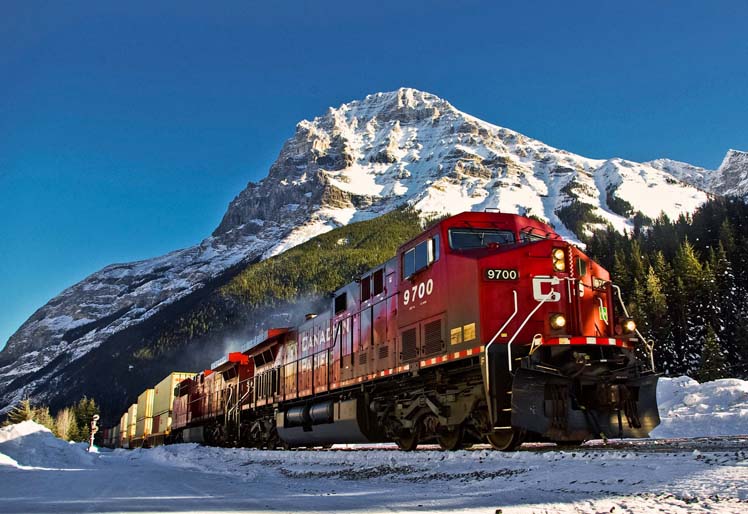
North America - Canada's two major railways are well positioned to weather potential economic headwinds and the U.S.-China trade war,
analysts say, as ongoing investments in new cars and track bolster crude-by-rail and commodities shipments.
Canadian National Railway Co. (CN) and Canadian Pacific Railway Ltd. (CP)shipped 23 percent more oil and petroleum in 2018 to drive a four percent increase in
total freight traffic, according to the Association of American Railroads.
Crude-by-rail exports have spiked over the past year amidst a pipeline shortage and a big discount on Western Canadian Select oil, hitting a record 327,229
barrels per day in October, a 58 percent year-over-year increase, according to the National Energy Board.
With Enbridge's Line 3 not set to come online until late this year and the Trans Mountain expansion facing uncertainty, CN and CP can expect continued high
demand for shipments of the black stuff, DBRS analyst Amaury Baudouin said.
Lessons Learned
The railways have drawn on lessons from unfilled contracts following the crude-by-rail boom five years ago, entering into multi-year contracts with oil
shippers that set minimum volumes and higher fees to help insulate them from volatile demand, he said.
"I think lessons of the past have been learned, and a lot of this capacity is being contracted on a take-or-pay basis... which means that if the economics
of Western Canadian oil change a lot, CN and CP will still have that oil to move around to the U.S. refineries and the Gulf Coast."
In 2017 petroleum, chemicals and plastics brought in 16 percent of CN's $13.04 billion in revenue and 14 percent of CP's $6.38 billion revenues.
With crude comprising only a portion of those categories, surging sales will have a limited impact on the bottom line and the stock price, Baudouin
cautioned.
More Cars
Over the past year, Montreal-based CN has invested in rail cars, track doubling, and expanded rail yards, particularly between Chicago and the West Coast, to
the tune of $3.5 billion, 30 percent more than its three-year average.
It has plans to keep building in 2019.
Calgary-based CP, meanwhile, aims to have 1,000 more grain cars in service by this spring, following CN's order for 1,000 hoppers last May.
The moves follow a major backlog in grain shipments last winter.
However both railways have roared back from the bottleneck.
CP moved 2.64 million tonnes of Canadian grain and grain products in October, a company record for monthly shipments that it nearly matched in
November.
CN reported the highest quarterly revenues in its 99 year history in October, spurred on by revenue growth of between 15 percent and 25 percent for grain and
fertilizers as well as metals and minerals, forest products, and coal.
CP, though lacking its rival's broad access to maritime ports, traffics heavily in bulk commodities such as grain, potash, coal, and fertilizer that amount to
44 percent of its revenue, according to a DBRS report from October.
"There's this shift in China where the diet is changing to more Western-style habits and they're eating a lot more grain. That also demands a lot more
potash 1/8 for fertilizer 3/8 than the traditional seafood-based diet," Deutsche Bank analyst Seldon Clarke said.
Expanded B.C. Port
The expanded port at Prince Rupert, B.C., where CN has laid track directly on the dock, is another reason for long-term optimism.
It offers shippers a swift route for Asian produced goods, avoiding the congestion of Vancouver and Los Angeles.
Meanwhile, more grain is being stuffed into shipping containers and dropped on carriers bound for China, he said.
Lumber and automotive parts, however, pose a potential weak point for both railways.
"The American housing market is looking pretty weak and not going to have a sharp turnaround any time soon. Same goes for the auto industry in the
U.S.," Clarke said, pointing to plummeting lumber prices.
Automotive shipment revenues dropped 21 percent for CP and 10 percent for CN in 2017, with further declines in 2018.
Ongoing steel and aluminum tariffs affect only a fraction of the railways' shipments, but CN and CP remain vulnerable to the fallout from U.S.-China trade
tensions and a potential economic slowdown following a decade of global growth, Clarke said.
"You're seeing a slowdown in economic activity in China, and it's probably a fair guess to say that that starts to impact North America at some
point."
Author unknown.
provisions in Section 29 of the Canadian
Copyright Modernization Act.


